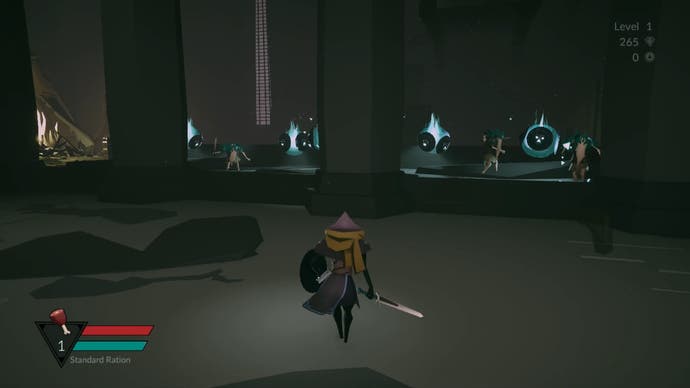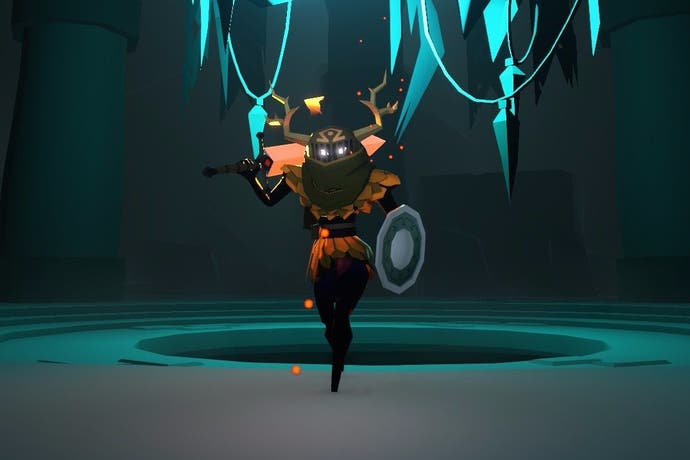Necropolis review
Pyramid scheme.
There's something captivating about games that keep their lore a mystery. In the same way a rarely glimpsed monster is far scarier on the silver screen, a game world explored through tiny story fragments can be spellbinding. Jaws had a fin gliding through the water; the terrifyingly intangible Bob seemed at once everywhere and nowhere in Twin Peaks; and Necropolis has a carved stone tablet complaining about how clean the floor was before your enemies 'threw a kegger'.
The lore of Necropolis is filled with strange arcane tales, split into tiny fragments and scattered throughout the procedurally generated world. It's hugely engrossing, even if I have a strong suspicion that it might all be nonsense. Most of this decidedly silly mythos - the fact the Necropolis' creator Abraxos also does his laundry there, for instance - comes to you by way of a chap called the Brazen Head. The keeper of the Necropolis is an eccentric fellow, as I suppose a millennia-old talking pyramid would be, and serves as your guide through the world. If you please him, he will reward you. If you don't, well it really won't bother him either way. See, the best thing about the Brazen Head is that he's seen so many adventurers enter the necropolis and die horribly that one more really doesn't make a difference. He'll follow your progress, sure, but he'll do so in a vaguely disinterested, sleepy sort of way. He's basically an eldritch version of Bagpuss, and the effect is wonderful. His flagrant disregard for your wellbeing also serves to hammer home the lesson all roguelikes must teach their players: 'you are going to die.'
Functionally, Necropolis works like this: each floor is a sprawling labyrinth which you need to explore in search of a special door, accumulating money and items along the way. Inside the special door is a fountain which will boost your stats, as well as a lift to take you down to the next level. The catch is that the special door costs money to use and the same goes with the fountain; if you want the blessing of the gods, you'll have to stump up. You can ignore the fountain, of course, but you'll regret it later on. Thus, whereas other roguelikes like Spelunky and The Binding of Isaac merrily lend themselves to speedruns, Necropolis is a game that rewards patience. It's also one that rewards diligence - the Brazen Head doles out a steady trickle of objectives for you to complete on each run, ranging from such things as killing rats to crafting bombs or incanting spells. Completing each objective grants a Point of Favour with the Brazen Head. Collecting lots of cash will also grant you some of these points, which I'll get back to in just a moment.

As in most roguelikes, you start with the most basic gear and try to get as far as possible before dying. Any items you accumulate along the way are permanently lost on death, when it's back to square one. Necropolis' notable exception comes in the form of codexes, which is where those points of favour come in handy. Each codex provides a different character trait, some of which are more immediately obvious and useful than others. 'Vampirism is your friend' allows you to steal life from enemies when doing them harm, for instance, whereas 'rotten is just another word for delicious' keeps you from vomiting when eating inferior foodstuffs found in the necropolis. You can only have one of these active at any one time and have to select one afresh each time you start a run which, frankly, is a faff.
The levels themselves are fairly sprawling. Wading through the pockets of enemies, lootable chests and, of course, smashable pottery takes quite a long time, contributing significantly to the relaxed pacing that so characterises Necropolis. From the moment you enter the first level and realise the ceiling stretches so high as to be out of sight, you get the sense Necropolis is going to be a slower, more meditative kind of roguelike - an impression that's reinforced wholeheartedly by the combat.
It might be the way they're animated, but the enemies in Necropolis saunter up to you. There's no other way to describe it - they saunter. They also telegraph their attacks quite clearly, committing fully to the animation as soon as it's begun. As a result, the combat in Necropolis is heavily focused around dodging, blocking and counterattacking in a way any Dark Souls fan will find instantly familiar. Timing is vital in order to succeed, as is managing your stamina bar; the latter being particularly interesting in that it can quite easily leave you hobbled. During combat you have the option to use charged attacks in combat - and these are hugely effective - but using them shortens your stamina bar, leaving you with less regenerating stamina to play with. You can regain this lost stamina by using a healing item, but that of course puts a strain on the resources at your disposal. This tension between an aggressive playstyle and your capacity to survive is a nice touch.

While your enemies do definitely saunter, however, that's not to say they aren't dangerous, or that Necropolis isn't exacting. It is, even if the combat system doesn't feel quite so fluid or well executed as that of its contemporaries, and being dogmatic about your approach to combat is only going to get you killed. A great part of getting through the more challenging fights is getting a good read on the situation and responding accordingly; a number of the enemies you'll encounter, for example, are themselves enemies, so kiting one group of bad guys into another group is often your best chance of making it through unscathed. Another small but hugely satisfying feature of Necropolis' combat is that friendly fire is turned on for your enemies; bunching them up and letting them do the hard work is very pleasing, but also means that finding a good choke point can sometimes make the difference between life and death.
Interestingly, friendly fire is also turned on when playing cooperatively, which puts a very different spin on things. Playing with others in Necropolis is an excellent way to ensure your success - not least because other players can revive you if you die - but it also fundamentally changes the pace of combat. Because your allies can hurt you just as easily as your enemies, you're forced to adopt a new sense of ebb and flow, either running off to fight your own enemies (and running the risk of getting overwhelmed) or trying to time your attacks around those of your companions. It's a tricky experience (and one that had us immediately resort to using Discord to chat to one another), but an enriching one nonetheless.
If I had to make one criticism of Necropolis, it would be that it's prone to causing a sense of roguelike-specific vertigo in the player. While the relaxed pacing is for the most part a good thing, a run can take so long (you're looking at around two hours to reach level six) that starting one can feel a little daunting; fatiguing, even. Necropolis is a well thought out and very engaging roguelike, but it's also a significant time investment. Each part of the puzzle you uncover, each moment of discovery is lovely, but it all boils down to how long you can spare to reach the next one.
All in all, I like Necropolis. It's a game that shares its secrets sparingly, inviting you to poke about the place rather than charging through like the gods' chosen hero - because you're not playing as the chosen hero, you're just a soon-to-be-dead adventurer in a long line of now dead adventurers; eminently expendable. You'll return to the main menu and the Brazen Head will tut, rolling his one gigantic eye as he waits for the next brave soul to enter his realm. The only question is how long you're willing to spend being that brave soul.



